Battle of Jutland order of battle

The Battle of Jutland was fought on 31 May and 1 June 1916, in the waters of the North Sea, between forces of the Royal Navy Grand Fleet and Imperial German Navy High Seas Fleet. The battle involved 250 warships, and, in terms of combined tonnage of vessels engaged, was the largest naval battle in history.
The engagement was the result of the high commands of the two nations' eagerness to give their publics a victory in contrast to the stalemate on the ground in Western Europe (the Battle of Verdun had been underway for three months at the time the opposing fleets sortied). The German plan was to lure the British battlecruisers into a trap where they could be defeated by a superior force of battleships without encountering the rest of the Grand Fleet. Aware of German naval movements, the British fleet sortied to support their battlecruisers and bring the German fleet to battle. [1]
In the event, the battle had no impact on the course of the war and victory was claimed by both sides.
Summary
[edit]Ships present
[edit]| Royal Navy | Imperial German Navy | |
|---|---|---|
| Dreadnoughts | 28 in total 8 × 15-inch
10 × 14-inch
10 × 13.5-inch
14 × 12-inch
10 × 12-inch
8 × 12-inch
|
16 in total 10 × 12-in.
8 × 12-in.
8 × 11-in.
|
| Pre-dreadnought battleships | 6 total' 4 × 11-in.
| |
| Battlecruisers | 9 total 8 × 13.5-in.
8 × 12-in.
|
5 total 8 × 12-in (30.5 cm)
10 × 11-in.
8 × 11-in.
|
| Armoured cruisers | 8 total 4 × 9.2-in., 5 × 7.5-in.
4 × 9.2-in., 2 × 7.5-in.
4 × 9.2-in., 5 × 6-in.
3 × 7.5-in., 3 × 6-in.
| |
| Smaller ships | 26 × light cruisers 79 × destroyers (including one destroyer-minelayer) |
11 × light cruisers 61 × torpedo boats |
British capital ships carried a larger weight of broadside—332,360 lb (150.76 t) compared to 134,216 lb (60.879 t)—than the German ones.[2]
The German Navy's torpedo boats were of similar size and function to the destroyers in the Royal Navy, and are often referred to as such.[citation needed]
Losses
[edit]| Pre-dreadnought battleships |
Battlecruisers | Armoured cruisers |
Light cruisers |
Destroyers / Torpedo boats | |
|---|---|---|---|---|---|
| Royal Navy | HMS Invincible (31 May) HMS Queen Mary (31st) HMS Indefatigable (31 May) |
HMS Defence (31 May) HMS Warrior (1 June) HMS Black Prince (1 June) |
3 (31 May) 5 (1 June) | ||
| Imperial German Navy | SMS Pommern (1 June) | SMS Lützow (1 June) | SMS Frauenlob (31 May) SMS Rostock (1 June) SMS Elbing (1 June) SMS Wiesbaden (1 June) |
3 (31 May) 2 (1 June) |
Abbreviations
[edit]Officers killed in action are indicated thus: †
Abbreviations for officers’ ranks (German ranks translated according to current NATO practice)[a][clarification needed]:
- Adm / Admiral
- VAdm / Vice-admiral : Vizeadmiral / VAdm
- RAdm / Rear-admiral : Konteradmiral / KAdm
- Cdre / Commodore : Kommodore / Kom
- Capt / Captain : Kapitän zur See / KptzS
- Cdr / Commander : Fregattenkapitän / FKpt
- Lt Cdr / Lieutenant-commander : Korvettenkapitän / KKpt
- Lt / Lieutenant : Kapitänleutnant / KptLt
- SLt / Sub-lieutenant : Oberleutnant zur See / OLtzS
Other abbreviations
- Frhr:Freiherr / title in the Prussian nobility equivalent to Baron)
- SMS: Seiner Majestät Schiff / German; translation: His Majesty's Ship)
- the Hon.: The Honourable
Royal Navy
[edit]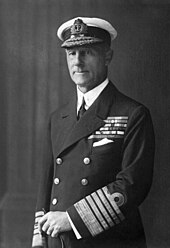



Grand Fleet
[edit]Began sortie from Scapa Flow 9.30pm 28 May[4]
The Grand Fleet[5][6] was the main body of the British Home Fleets in 1916, based at Scapa Flow in the Orkney Islands and Invergordon on the Cromarty Firth in Scotland.[b]
- Commander-in-chief, Grand Fleet: Admiral Sir John Jellicoe, KCB KCVO in HMS Iron Duke
- Second in Command, Grand Fleet: Vice-Admiral Sir Cecil Burney, KCB KCMG in HMS Marlborough
- Chief of Staff: Vice-Admiral Sir Charles Madden, KCB CVO
- Captain of the Fleet: Commodore Lionel Halsey, C.B., C.M.G., AdC.
- Master of the Fleet: Captain Oliver Elles Leggett
Battleships
[edit]- 2nd Battle Squadron (battleships)[c]
- Vice-Admiral Sir Thomas Martyn Jerram
- Sortied from Cromarty Firth; rendezvoused with Jellicoe's force around noon 31 May
- 1st Division: Vice-Admiral Jerram
- HMS King George V (flagship): Capt Frederick Field
- HMS Ajax: Capt George Henry Baird
- HMS Centurion: Capt Michael Culme-Seymour
- HMS Erin: Capt the Hon. Victor Stanley
- 2nd Division: Rear Admiral Arthur Leveson
- HMS Orion (flagship): Capt Oliver Backhouse
- HMS Monarch: Capt George Borrett
- HMS Conqueror: Capt Hugh Tothill
- HMS Thunderer: Capt James Fergusson
- Fleet Flagship (at head of 3rd Division but not part of 4th Battle Squadron)
- 4th Battle Squadron (battleships)
- Vice-Admiral Sir Frederick Charles Doveton Sturdee, 1st Baronet
- 3rd Division[d]: RAdm Alexander Duff
- HMS Royal Oak: Capt Crawford Maclachlan
- HMS Superb (flagship): Capt Edmond Hyde Parker
- HMS Canada: Capt William Nicholson
- 4th Division: VAdm Sturdee
- HMS Benbow (flagship): Capt Henry Wise Parker
- HMS Bellerophon: Capt Edward Francis Bruen
- HMS Temeraire: Capt Edwin Veale Underhill
- HMS Vanguard: Capt James Douglas Dick
- 3rd Division[d]: RAdm Alexander Duff
- 1st Battle Squadron (battleships)[e]
- Admiral Sir Cecil Burney
- Chief of Staff: Commodore Percy Grant
- 5th Division: Rear Admiral Ernest Gaunt
- HMS Colossus (flagship): Capt Dudley Pound
- HMS Collingwood: Capt James Clement Ley
- HMS St. Vincent: Capt William Wordsworth Fisher
- HMS Neptune Capt Vivian Bernard
- 6th Division: VAdm Burney
- HMS Marlborough (flagship): Capt George Parish Ross
- HMS Revenge: Capt Edward Buxton Kiddle
- HMS Hercules: Capt Lewis Clinton-Baker
- HMS Agincourt: Capt Henry Montagu Doughty
- 5th Division: Rear Admiral Ernest Gaunt
Cruisers
[edit]

- 1st Cruiser Squadron (armoured cruisers)[f]
- Rear-Admiral Sir Robert Arbuthnot, 4th Baronet †
- HMS Defence (sunk 31 May) (flagship): Capt Stanley Venn Ellis †
- HMS Warrior (sunk 1 June): Capt Vincent Barkly Molteno
- HMS Duke of Edinburgh: Capt Henry Blackett
- HMS Black Prince (sunk 1 June): Capt Thomas Parry Bonham †
- 2nd Cruiser Squadron (armoured cruisers)[g]
- Rear-Admiral Herbert Heath
- HMS Minotaur (flagship): Capt Arthur Cloudesley Shovel Hughes D'Aeth [h]
- HMS Hampshire: Capt Herbert John Savill
- HMS Shannon: Capt John Saumarez Dumaresq
- HMS Cochrane: Capt Eustace La Trobe Leatham
- 4th Light Cruiser Squadron
- Commodore Charles Edward Le Mesurier
- HMS Calliope: Commodore Le Mesurier
- HMS Constance: Capt Cyril Samuel Townsend
- HMS Comus: Capt Alan Hotham
- HMS Caroline: Capt Henry Crooke
- HMS Royalist: Capt the Hon. Herbert Meade
- Light cruisers attached for repeating visual signals
- HMS Boadicea: Capt Louis Charles Stirling Woollcombe (attached to 2nd B.S.)
- HMS Active: Capt Percy Withers (attached to Fleet Flagship)
- HMS Blanche: Capt John Casement (attached to 4th B.S.)
- HMS Bellona: Capt Arthur Brandreth Scott Dutton (attached to 1st B.S.)
Other ships under direct command of the Commander-in-Chief[i]
- HMS Abdiel: Cdr Berwick Curtis (destroyer-minelayer)
- HMS Oak: Lt Cdr Douglas Faviell (destroyer)
Destroyers
[edit]
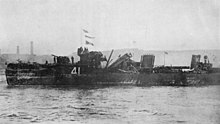
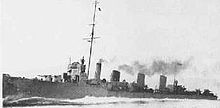


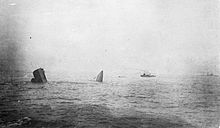
- Captain Charles John Wintour †
- HMS Tipperary (Faulknor-class flotilla leader, sunk 1 June) : Capt Wintour †
- First half-flotilla / 4th D.F.
- HMS Spitfire: Lt Cdr Clarence Walter Eyre Trelawney
- HMS Sparrowhawk (scuttled 1 June following collision): Lt Cdr Sydney Hopkins
- HMS Garland: Lt Cdr Reginald Stannus Goff
- HMS Contest: Lt Cdr Ernald Gilbert Hoskins Master
- Group 8 / 4th D.F.[k]
- HMS Owl: Cdr Robert Gerald Hamond
- HMS Hardy: Cdr Richard Anthony Aston Plowden
- HMS Mischief: Lt Cdr the Hon. Cyril Augustus Ward (from 12th D.F.)
- HMS Midge: Lt Cdr James Robert Carnegie Cavendish
- Group 8 / 4th D.F.[k]
- Second half-flotilla / 4th D.F.
- HMS Broke (Faulknor-class flotilla leader): Cdr Walter Lingen Allen
- 3rd Division / 4th D.F.
- HMS Porpoise: Cdr Hugh Davenport Colville
- HMS Unity: Lt Cdr Arthur Macaulay Lecky
- 4th Division / 4th D.F.
- HMS Achates: Cdr Reginald Becher Caldwell Hutchinson, D.S.C.
- HMS Ambuscade: Lt Cdr Gordon Alston Coles
- HMS Ardent (sunk 1 June): Lt Cdr Arthur Marsden
- HMS Fortune (sunk 1 June): Lt Cdr Frank Goodrich Terry †
- Commanded by Commodore Hawksley in HMS Castor, a light cruiser
- First half-flotilla / 11th D.F.
- 1st Division / 11th D.F.
- HMS Ossory: Cdr Harold Victor Dundas
- HMS Martial: Lt Cdr Julian Harrison
- HMS Magic: Lt Cdr Gerald Charles Wynter
- HMS Minion: Lt Cdr Henry Clive Rawlings
- 2nd Division / 11th D.F.
- HMS Mystic: Cdr Claud Finlinson Allsup
- HMS Mons: Lt Cdr Robert Makin
- HMS Mandate: Lt Cdr Edward McConnell Wyndham Lawrie
- HMS Michael: Lt Cdr Claude Lindsay Bate
- 1st Division / 11th D.F.
- Second half-flotilla/11th D.F.
- HMS Kempenfelt (Marksman-class flotilla leader): Cdr Harold Ernest Sulivan
- 3rd Division / 11th D.F.
- HMS Marne: Lt Cdr George Bibby Hartford
- HMS Milbrook: Lt Charles Granville Naylor
- HMS Manners: Lt Cdr Gerald Harrison
- 4th Division / 11th D.F.
- HMS Moon: Cdr (Acting) William Dion Irvin
- HMS Mounsey: Lt Cdr Ralph Vincent Eyre
- HMS Morning Star: Lt Cdr Hugh Undecimus Fletcher
- 3rd Division / 11th D.F.
- Captain Anselan John Buchanan Stirling
- HMS Faulknor (Faulknor-class flotilla leader): Capt Stirling
- First half-flotilla / 12th D.F.
- 1st Division / 12th D.F.[9]
- HMS Obedient: Cdr George William McOran Campbell
- HMS Mindful: Lt Cdr John Jackson Cuthbert Ridley
- HMS Marvel: Lt Cdr Reginald Watkins Grubb
- HMS Onslaught: Lt Cdr Arthur Gerald Onslow †
- 2nd Division / 12th D.F.
- HMS Maenad: Cdr John Pelham Champion
- HMS Narwhal: Lt Cdr Henry Victor Hudson
- HMS Nessus: Lt Cdr Eric Quentin Carter
- HMS Noble: Lt Cdr Henry Percy Boxer
- 1st Division / 12th D.F.[9]
- Second half-flotilla / 12th D.F.: Cdr Norton Allen Sulivan
- HMS Marksman (Marksman-class flotilla leader): Cdr Norton Allen Sulivan
- HMS Opal: Cdr Charles Geoffrey Coleridge Sumner
- HMS Nonsuch: Lt Cdr Herbert Inglis Nigel Lyon
- HMS Menace: Lt Cdr Charles Astley Poignand
- HMS Munster: Lt Cdr Spencer Francis Russell
- HMS Mary Rose: Lt Cdr Edwin Anderson Homan
3rd Battle Cruiser Squadron
[edit]
This squadron, temporarily attached to the Grand Fleet from the Battle Cruiser Fleet, was stationed ahead of the main body, with the intention that it join Beatty when the action began.
Rear-Admiral The Hon. Horace Hood, (KIA)
- Battlecruisers
- HMS Invincible (sunk 31 May) (flagship): Capt Arthur Lindesay Cay (KIA)
- HMS Inflexible: Capt Edward Heaton-Ellis
- HMS Indomitable: Capt Francis William Kennedy
- Accompanying cruisers
- HMS Canterbury [n]: Capt Percy Royds
- HMS Chester [o]: Capt Robert Neale Lawson
- Attached destroyers [p]
- HMS Shark (sunk 31 May): Cdr Loftus William Jones (KIA)
- HMS Ophelia: Cdr Lewis Gonne Eyre Crabbe (Admiralty M-class destroyer)
- HMS Christopher: Lt Cdr Fairfax Moresby Kerr
- HMS Acasta: Lt Cdr John Ouchterlony Barron
Battle Cruiser Fleet
[edit]


This force of high-speed ships was subordinate to the Commander in Chief of the Grand Fleet, but operated independently as an advanced guard, intended to reconnoiter the enemy fleet and to engage enemy scouting forces. At its core were six battlecruisers, accompanied by 13 light cruisers, and escorted by 18 destroyers and an early aircraft carrier.
[q]
Sortied from Firth of Forth soon after 6.00pm 30 May[4]
Vice-Admiral Sir David Richard Beatty in HMS Lion
- Chief of Staff: Capt Rudolph Bentinck
Battlecruisers
[edit]HMS Lion: (flagship) Captain Ernle Chatfield
- 1st Battlecruiser Squadron: Rear Admiral Osmond Brock on Princess Royal
- HMS Princess Royal (flagship): Capt Walter Cowan,
- HMS Queen Mary (sunk 31 May): Capt Cecil Prowse (KIA)
- HMS Tiger: Capt Henry Bertram Pelly.
- 2nd Battlecruiser Squadron[r]: Rear Admiral William Pakenham,
- HMS New Zealand (flagship): Capt John Green
- HMS Indefatigable (sunk 31 May): Capt Charles Fitzgerald Sowerby (KIA)
Light cruisers
[edit]- 1st Light Cruiser Squadron: Cdre Edwyn Alexander-Sinclair
- HMS Galatea Cdre Alexander-Sinclair
- HMS Phaeton: Capt John Cameron
- HMS Inconstant: Capt Bertram Thesiger
- HMS Cordelia: Capt Tufton Beamish
- 2nd Light Cruiser Squadron: Cdre William Goodenough
- HMS Southampton: Cdre Goodenough
- HMS Birmingham: Capt Arthur Duff
- HMS Nottingham: Capt Charles Blois Miller
- HMS Dublin: Capt Albert Charles Scott
- 3rd Light Cruiser Squadron: RAdm Trevylyan Napier
- HMS Falmouth (flagship): Capt John Douglas Edwards
- HMS Yarmouth: Capt Thomas Drummond Pratt
- HMS Birkenhead: Capt Edward Reeves
- HMS Gloucester: Capt William Frederick Blunt
Attached vessel
- seaplane tender HMS Engadine: Lt Cdr Charles Gwillim Robinson
- aircraft: 2 Short Type 184 reconnaissance seaplanes, 2 Sopwith Baby fighter seaplanes
Destroyers
[edit]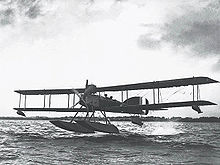

13th Destroyer Flotilla[s]
Captain James Uchtred Farie
- HMS Champion (light cruiser): Capt Farie
- 1st Division / 13th D.F.
- HMS Obdurate: Lt Cdr Cecil Henry Hulton Sams
- HMS Nerissa: Lt Cdr Montague George Bentinck Legge
- HMS Termagant: Lt Cdr Cuthbert Patrick Blake (attached from 10th D.F., Harwich Force)
- HMS Moresby: Lt Cdr Roger Vincent Alison (detached to escort HMS Engadine)
- 2nd Division / 13th D.F.[10]
- HMS Nestor (sunk 31 May): Cdr the Hon. Edward Bingham
- HMS Nomad (sunk 31 May): Lt Cdr Paul Whitfield
- HMS Nicator: Lt Jack Ernest Albert Mocatta
- HMS Onslow: Lt Cdr John Tovey (detached to escort HMS Engadine)
- 3rd Division / 13th D.F.[11]
- HMS Narborough: Lt Cdr Geoffrey Corlett
- HMS Pelican: Lt Cdr Kenneth Adair Beattie
- HMS Petard: Lt Cdr Evelyn Thomson
- HMS Turbulent (sunk 1 June)[t]: Lt Cdr Dudley Stuart †
- Attached Harwich Destroyers (9th Destroyer Flotilla): Cdr Malcolm Lennon Goldsmith[u]
- 1st division / 9th D.F.
- HMS Lydiard: Cdr Goldsmith
- HMS Liberty: Lt Cdr Philip Wilfred Sidney King
- HMS Landrail: Lt Cdr Francis Edward Henry Graham Hobart
- 2nd division / 9th D.F.
- HMS Moorsom: Cdr John Coombe Hodgson (from 10th D.F.)
- HMS Laurel: Lt Henry Dawson Crawford Stanistreet
- HMS Morris: Lt Cdr Edward Sidney Graham (from 10th D.F.)
- 1st division / 9th D.F.
5th Battle Squadron
[edit]

The 5th Battle Squadron was a special unit of fast Queen Elizabeth-class battleships, intended to act as the vanguard of the main battle line. At the Battle of Jutland, it operated with the Battlecruiser Fleet, and was escorted by the 1st Destroyer Flotilla.[v]
Rear-Admiral Hugh Evan-Thomas
Sortied from Firth of Forth with the Battle Cruiser Fleet soon after 6.00pm 30 May
- Battleships
- HMS Barham (flagship): Capt Arthur William Craig
- HMS Valiant: Capt Maurice Woollcombe
- HMS Warspite: Capt Edward Montgomery Phillpotts
- HMS Malaya: Capt the Hon. Algernon Boyle
- 1st Destroyer Flotilla [w] [13][14]
- HMS Fearless (light cruiser): Capt Charles Donnison Roper
- HMS Defender: Lt Cdr Laurence Reynolds Palmer
- 1st Division / 1st D.F.
- HMS Acheron: Cdr Charles Ramsey
- HMS Ariel: Lt Cdr Arthur Grendon Tippet
- HMS Attack: Lt Cdr Charles Herbert Neill James
- HMS Hydra: Lt Francis George Glossop
- 2nd Division / 1st D.F.
- HMS Badger: Cdr Charles Albert Fremantle
- HMS Lizard: Lt Cdr Edward Brooke
- HMS Goshawk: Cdr Dashwood Fowler Moir
- HMS Lapwing: Lt Cdr Alexander Hugh Gye
Imperial German Navy
[edit]
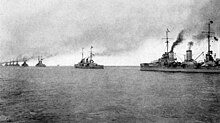




High Seas Fleet (Hochseeflotte)
[edit]The High Seas Fleet was the main body of the German surface navy, principally based at Wilhelmshaven, on the Jade River in North-West Germany.[15][16]
- Commander-in-Chief (Chef der Hochseeflotte): Vizeadmiral Reinhard Scheer in SMS Friedrich der Grosse
- Chief of Staff: KptzS Adolf von Trotha
- Chief of Operations: KptzS Magnus von Levetzow
Battleships
[edit]- 3rd Battle Squadron (III. Geschwader) (battleships)[x]
- Konteradmrial Paul Behncke
- Flag lieutenant: Korvettenkapitän Frhr Ernst von Gagern
- 5th Division: KAdm Behncke
- SMS König (flagship): KptzS Friedrich Brüninghaus
- SMS Grosser Kurfürst: KptzS Ernst Goette
- SMS Kronprinz: KptzS Constanz Feldt
- SMS Markgraf: KptzS Karl Seiferling
- 5th Division: KAdm Behncke
- 6th Division: KAdm Hermann Nordmann
- SMS Kaiser (flagship): KptzS Walter Freiherr von Keyserlingk
- SMS Prinzregent Luitpold: KptzS Karl Heuser
- SMS Kaiserin: KptzS Karl Sievers
- 6th Division: KAdm Hermann Nordmann
- Fleet Flagship (Flaggschiff der Hochseeflotte)[y]
- SMS Friedrich der Grosse: KptzS Theodor Fuchs
- Fleet Flagship (Flaggschiff der Hochseeflotte)[y]
- 1st Battle Squadron (I. Geschwader) (battleships)[z]
- Vizeadmiral Ehrhard Schmidt
- Flag lieutenant: Korvettenkapitän Wolfgang Wegener
- 1st Division: VAdm Schmidt
- SMS Ostfriesland (flagship): KptzS Ernst-Oldwig von Natzmer
- SMS Thüringen: KptzS Hans Küsel
- SMS Helgoland: KptzS Friedrich von Kameke
- SMS Oldenburg: KptzS Wilhelm Höpfner
- 1st Division: VAdm Schmidt
- 2nd Division: KAdm Walter Engelhardt
- SMS Posen (flagship): KptzS Richard Lange
- SMS Rheinland: KptzS Heinrich Rohardt
- SMS Nassau: KptzS Robert Kühne
- SMS Westfalen: KptzS Johannes Redlich
- 2nd Division: KAdm Walter Engelhardt
- 2nd Battle Squadron (II. Geschwader) (battleships)[aa]
- Konteradmrial Franz Mauve
- Flag lieutenant: Korvettenkapitän Willy Kahlert
- 3rd Division: KAdm Mauve
- SMS Deutschland (flagship): KptzS Hugo Meurer
- SMS Hessen: KptzS Rudolf Bartels
- SMS Pommern (sunk 1st June): KptzS Siegfried Bölken †
- 3rd Division: KAdm Mauve
- 4th Division: KAdm Frhr Gottfried von Dalwigk zu Lichtenfels
- SMS Hannover (flagship): KptzS Wilhlem Heine
- SMS Schlesien: KptzS Friedrich Behncke
- SMS Schleswig-Holstein: KptzS Eduard Varrentrapp
- 4th Division: KAdm Frhr Gottfried von Dalwigk zu Lichtenfels
Light cruisers
[edit]- IV. Aufklärungsgruppe ("4th Scouting Group", light cruisers)[ab]
- Kommodore Ludwig von Reuter
- Flag lieutenant: Korvettenkapitän Heinrich Weber
- SMS Stettin (flagship): FKpt Friedrich Rebensburg
- SMS München: KKpt Oscar Böcker
- SMS Frauenlob (sunk 31st May): FKpt Georg Hoffman †
- SMS Stuttgart: FKpt Max Hagedorn
- SMS Hamburg: KKpt Gerhard von Gaudecker [ac]
Torpedo boats
[edit]German Große Torpedoboote ("large torpedoboats") were the equivalent of British destroyers [ad].
- First Leader of Torpedo-Boats
- Kommodore Andreas Michelsen
- SMS Rostock (scuttled 1st June) (light cruiser; flagship 1st Leader of Torpedo-Boats): FKpt Otto Feldmann [ae]
- 1st Torpedo-Boat Flotilla (I. Torpedoboots-Flottille)[af]
- 1st Half-Flotilla (1. Halbflottille)[ag]: KptLt Conrad Albrecht
- SMS G39 (lead boat, half-flotilla): OLtzS Franz-Ferdinand von Loefen
- SMS G40: KptLt Richard Beitzen
- SMS G38: KptLt Hermann Metger
- SMS S32: KptLt Hermann Froelich
- 1st Half-Flotilla (1. Halbflottille)[ag]: KptLt Conrad Albrecht
- 3rd Torpedo-Boat Flotilla (III. Torpedoboots-Flottille)
- Korvettenkapitän Wilhelm Hollmann
- SMS S53 (lead boat, flotilla): KptLt Friedrich Götting
- 5th Half-Flotilla (5. Halbflottille) [ah]: KptLt Theophil Gautier
- 6th Half-Flotilla (6. Halbflottille)[ai]: Korvettenkapitän Theodor Riedel †[aj]
- SMS V48 (lead boat, half-flotilla) (sunk 31st May): KptLt Friedrich Eckoldt †
- SMS S54: KptLt Otto Karlowa
- SMS G42: KptLt Bernd von Arnim
- 5th Torpedo-Boat Flotilla (V. Torpedoboots-Flottille)
- Korvettenkapitän Oskar Heinecke
- SMS G11 (lead boat, flotilla): KptLt Adolf Müller
- 9th Half-Flotilla (9. Halbflottille): KptLt Gerhard Hoefer
- 10th Half-Flotilla (10. Halbflottille): KptLt Friedrich Klein
- 7th Torpedo-Boat Flotilla (VII. Torpedoboots-Flottille)
- Korvettenkapitän Gottlieb von Koch
Scouting Force
[edit]



It is perhaps significant that all [British World War I] losses in big ships (Audacious, Indefatigable, Invincible, Queen Mary and Vanguard) were finally due to internal explosions, whereas no large German ships were lost from this cause.
Warships of World War I (1961),
p. 37

- Commander, Scouting Forces (Befehlshaber die Aufklärungsstreitkräfte): Vizeadmiral Franz Hipper
- Flag lieutenant: Korvettenkapitän Erich Raeder[al]
Battlecruisers
[edit]- 1st Scouting Group (I. Aufklärungsgruppe)
- Vizeadmiral Hipper
- SMS Lützow (flagship) (scuttled 1 June): KptzS Victor Harder
- SMS Derfflinger: KptzS Johannes Hartog
- SMS Seydlitz: KptzS Moritz von Egidy
- SMS Moltke: KptzS Johannes von Karpf
- SMS Von der Tann: KptzS Hans Zenker
Light cruisers
[edit]- 2nd Scouting Group (II. Aufklärungsgruppe) [am]
- Konteradmiral Friedrich Boedicker
- SMS Frankfurt (flagship): KptzS Thilo von Trotha
- SMS Elbing (scuttled 1 June): KFpt Rudolf Madlung
- SMS Pillau: KFpt Konrad Mommsen
- SMS Wiesbaden (sunk 1 June): KFpt Fritz Reiß †
Torpedo boats
[edit]- Second Leader of Torpedo-Boats
- Kommodore Paul Heinrich
- SMS Regensburg (light cruiser; flagship Second Leader of Torpedo-Boats): KFpt Bruno Heuberer[an]
- II. Torpedoboots-Flottille (2nd Torpedo-Boat Flotilla )
- Commander Heinrich Schuur
- SMS B98 (lead boat, flotilla): KptLt Theodor Hengstenberg
- ..3. Halbflottille (3rd Half-Flotilla) KKpt Heinrich Boest
- SMS G101 (lead boat, half-flotilla): KptLt Rudolf Schulte
- SMS G102: KptLt von Barendorff
- SMS B112: KptLt Carl August Claussen
- SMS B97: KptLt Leo Riedel
- ..3. Halbflottille (3rd Half-Flotilla) KKpt Heinrich Boest
- VI. Torpedoboots-Flottille (6th Torpedo-Boat Flotilla)
- Lieut. Commander Max Schultz
- SMS G41 (lead boat, flotilla): KptLt Hermann Boehm
- IX. Torpedoboots-Flottille (9th Torpedo-Boat Flotilla)
- Lieut. Commander Herbert Goehle
- SMS V28 (lead boat, flotilla): KptLt Otto Lenssen
- 18. Halbflottille (18th Half-Flotilla): Korvettenkapitän Werner Tillessen
- SMS V30 (lead boat, half-flotilla): OLtzS' Ernst Wolf
- SMS S34: KptLt Otto Andersen
- SMS S33: KptLt Waldemar von Münch
- SMS V29 (sunk 31 May): KptLt Erich Steinbrinck †
- SMS S35 (sunk 31 May): KptLt Friedrich Ihn †
- 18. Halbflottille (18th Half-Flotilla): Korvettenkapitän Werner Tillessen
Submarines
[edit]
Führer der Unterseeboote ("Leader of the U-boats") in the North Sea Fregattenkapitän Hermann Bauer in SMS Hamburg
The following submarines were deployed to attack the Grand Fleet in the North Sea during the period of the Battle of Jutland
- Off Terschelling:
- Off the Humber Estuary:
- UB-21: KptLt Ernst Hashagen
- Off Flamborough Head, Yorkshire:
- UB-22: OLtzS Bernhard Putzier
- Off the Firth of Forth, Scotland:
- U-52: KptLt Hans Walter
- U-24: KptLt Rudolf Schneider
- U-70: KptLt Otto Wünsche
- U-32: KptLt Fahr Edgar von Spiegel von und zu Peckelsheim
- U-51: KptLt Walter Rumpfel
- U-63: KptLt Otto Schultze
- U-66: KptLt Thorwald von Bothmer
- Off Peterhead, Scotland:
- U-47: KptLt Heinrich Metzger
- Off the Pentland Firth (between the Orkneys and the Scottish mainland):
Airships
[edit]
During the battle the Germans used the Zeppelin airships of the Naval Airship Section (Marine Luftschiff Abteilung) for scouting, although in the prevailing overcast conditions they were not particularly successful. The commander of the Naval Airship Section was Korvettenkapitän Peter Strasser, and they flew from bases at Nordholz and Hage in north-west Germany and Tondern (then part of Schleswig; the town became part of Denmark in 1920).
Sortied on 31 May
- L.9: KptzS August Stelling (Army Officer, on the inactive list)
- L.14: KptLt Alois Böcker
- L.16: KptLt Erich Sommerfeldt
- L.21: KptLt Max Dietrich
- L.23: KptLt Otto von Schubert
Sortied on 1 June
- L.11: KptLt Victor Schultze
- L.17: KptLt Herbert Ehrlich
- L.22: KptLt Martin Dietrich
- L.24: KptLt Robert Koch
Did not sortie during the Battle of Jutland
- L.13: KptLt Eduard Prölß
- L.30: OLtzS Horst Treusch von Buttlar-Brandenfels
Notes
[edit]- ^ In the First World War, German officers ranks were slightly higher in status: both Kapitän zur See and Fregattenkapitän were considered equivalent to a Captain in the Royal Navy; Korvettenkapitän was equivalent to a RN Commander; and Kapitänleutnant and Oberleutnant zur See to an RN Lieutenant (there was no German equivalent of a RN Lieutenant-Commander).[3] To avoid ambiguities (e.g. "Capt" could mean Kapitän zur See or Fregattenkapitän), the NATO system is employed.
- ^ 2nd Battle Squadron, 1st Cruiser Squadron and most of the 11th Destroyer Flotilla were at Invergordon, the remainder at Scapa Flow.
- ^ Based at Cromarty Firth.
- ^ Did not sail: HMS Emperor of India: Capt Charles Royds, the usual flagship of RAdm A. L. Duff, which was in dock.
- ^ Except HMS Royal Sovereign ( Capt. A. T. Hunt), which was still working up and did not sail with squadron.
- ^ Based at Cromarty Firth
- ^ The 2nd Cruiser Squadron had just absorbed Minotaur, Hampshire and Donegal from the disbanded 7th Cruiser Squadron on 30 May 1916. Did not sail: HMS Achilles (Captain F. M. Leake) which was in dock, and HMS Donegal (Capt. W. H. D'Oyly) which was on convoy escort duties in the Atlantic
- ^ There is confusion about the exact name of this officer: the Navy List throughout the period 1914–1923, and the London Gazette in 1916 (announcing his CB)[citation needed] give his name as listed here. However in both earlier and later editions of the Navy List, in his service record, as well as in some (but not all) earlier editions of the London Gazette list him as Arthur Cloudesly Shovel Hughes D'Aeth; the probate records for England and Wales (reporting his death on 23 August 1956) list him as Arthur Cloudesley Shovell Hughes D'Aeth[citation needed]; his obituary in The Times[7] gives his name as Arthur Cloudesley Shovel Hughes-D'Aeth. There was similar confusion about the spelling of the name of his namesake, the 18th century admiral; in his case 'Cloudesley Shovell' seems to be the accepted spelling nowadays[citation needed]
- ^ These did not form part of the line of battle; Abdiel was attached for tactical minelaying and Oak as a tender to the flagship. In addition the seaplane carrier HMS Campania: Capt Oliver Schwann sailed from Scapa Flow at 0130 hrs, 31 May, but was too slow to catch the fleet and was ordered to return at 04:30 hrs 31 May; and the kite balloon tender HMS Menelaus, Cdr C. W. N. McCulloch, did not sail[citation needed]
- ^ Three ships of the flotilla did not sail: Cockatrice and Paragon (both in refit) and HMS Victor.
- ^ Four destroyers detached from the 4th and 12th Destroyer Flotillas as escorts for the 2nd Cruiser Squadron.[8]
- ^ Based at Cromarty Firth except for HMS Marne, Manners, Michael and Mons at Scapa Flow. Did not sail: Musketeer (refit) and Marmion (refit).
- ^ Did not sail: Mameluke (refit, Glasgow) and Napier (refit, Glasgow); also HMS Mischief assigned to Group 8/4th D.F.
- ^ Attached from 5th Light Cruiser Squadron of the Harwich Force.
- ^ Attached from 3rd Light Cruiser Squadron.
- ^ all I-class destroyers, except Ophelia, attached from 4th Destroyer Flotilla.
- ^ Also known at different times during the war as Cruiser Force A, and the Battle Cruiser Force. At the time of Jutland, British battle cruisers were organized in three squadrons of three ships each, plus a fleet flagship. One of these Squadrons, the 3rd, was temporarily detached to the main body of the Grand Fleet. In addition there were three light cruiser squadrons and the 13th Destroyer Flotilla assigned (augmented at Jutland by additional attached destroyers). The Battle Cruiser Fleet was based at Rosyth on the Firth of Forth, Scotland.
- ^ HMAS Australia, the usual flagship of Rear Admiral Pakenham, was in dock at HMNB Devonport following repairs from a collision with New Zealand in April
- ^ Did not sail: HMS Negro, HMS Nepean, HMS Nereus, HMS Paladin, Penn and HMS Pigeon.
- ^ Attached from 10th D.F., Harwich Force
- ^ The 9th Destroyer Flotilla was part of the Harwich Force; this group of six destroyers were attached to the Battle Cruiser Fleet at the time of Jutland, and sailed under this designation with the organization given below.[12]
- ^ HMS Queen Elizabeth: Capt. G. P. W. Hope was being overhauled at Rosyth and did not sail
- ^ Attached from the Grand Fleet, in company with 5th Battle Squadron. Did not sail: HMS Botha (flotilla leader), HMS Archer, HMS Jackal, Phoenix and HMS Tigress (all refitting); HMS Beaver, HMS Druid, HMS Ferret, HMS Hind, HMS Hornet and Sandfly (all detached to the Nore, as escort to the 3rd Battle Squadron, which was guarding the Thames Estuary against a battlecruiser raid).
- ^ Did not sail: SMS König Albert: KptzS Thorbecke (condenser breakdown), SMS Bayern: KptzS Max Hahn (new construction, working up at Kiel), tender SMS T.39.
- ^ Did not sail: attached Fleet tenders SMS D4, SMS T96, SMS T98 and SMS T16.
- ^ Did not sail: attached tenders SMS Blitz and SMS T20
- ^ Did not sail: SMS Preussen: KptzS Frey, detached to Baltic as guard-ship at The Sound, and tenders SMS Pfeil and SMS T49.
- ^ Did not sail: SMS Berlin: FKpt Hildebrand, at Wilhelmshaven; and SMS Brummer: KptzS Wilhelm Schulz, at Kiel.
- ^ Flagship of the Leader of U-Boats: ‘‘KptzS’’ Hermann Bauer, attached to the 4th Scouting Group for tactical purposes.
- ^ German torpedo boat flotillas typically comprised two half-flotillas of five vessels each, plus an additional vessel for the flotilla commander. The boats were given numbers sequentially based on the order in which they were built. In addition, each boat had an initial letter denoting its builder: V for the Vulcan works at Stettin, S for the Schichau Works at Elbing in East Prussia, B for the Blohm und Voss Works at Hamburg, and G for Krupp's Germania Works at Kiel. All but one of the boats that fought at Jutland belonged to the number series than began with SMS V1 in 1911 (only SMS V189 belonged to the earlier series). Boats numbered 1-24 were of the 1911 Type[17] and served in the 5th and 7th Flotillas; boats numbered in the range 25-95 were of the 1913 Type[18] and served in the 1st, 3rd, 6th and 9th Flotillas. The vessels in the 2nd Flotilla were of a special large type built in 1914-15 and designated Torpedobootzerstörer ("torpedo boat destroyers") .[19]
- ^ Attached to the 4th Scouting Group for tactical purposes.
- ^ Did not sail: 2nd Half-Flotilla (2. halbsflottille), consisting of SMS G192: OLtzS Mewis, SMS G195: KptLt Mickel, SMS G196: KptLt Frhr von Seld, SMS G193: KptLt Oswald Paul and SMS S165: OLtzS Johannes-Henning Schneider, all under the command of FKpt Hans Kolbe.
- ^ Did not sail: SMS V190: Lt(Reserve) Bon-Ed, and SMS G197: KptLt Crelinger.
- ^ Did not sail: SMS V74: KptLt Günther Ehrlich, and SMS G85: KptLt Hans Herbert Stobwasser.
- ^ Did not sail: SMS V70: KptLt Lemelsen, SMS S55: KptLt Holscher.
- ^ Groos, Jutland Dispatches, Anlage 6./7. states KptLt Otto Karlowa in SMS S54 was the leader of the 6th Half-Flotilla on 30 May 1916; however from the narrative (Groos, Jutland Dispatches, p.304) it is clear that Riedel in V48 led the half-flotilla during the battle until the vessel was sunk in action and he was killed; the Second World War destroyer Z6 was named in Riedel's honor.[20]
- ^ SMS G172 did not sail as was refitting, SMS V186 sailed, but returned to port prior to action.
- ^ Sentenced to life imprisonment for war crimes at the Nuremberg Trials in 1946
- ^ Did not sail: SMS Graudenz: KptLt Beucer, under repair at Wilhelmshaven, and SMS Stralsund: ‘‘KptzS’’ Weniger, in dock at Kiel.
- ^ Attached to the 2nd Scouting Group for tactical purposes.
- ^ Did not sail: SMS S49: KptLt Bauftaedt and SMS V43: KptLt Carl.
References
[edit]- ^ Hough 1964, pp. 148–149.
- ^ "Edinburgh's War" (PDF). University of Edinburgh. Archived from the original (PDF) on 3 September 2014. Retrieved 27 August 2014.
- ^ Jane's Fighting Ships 1914. p. 155.
- ^ a b Hough 1964, p. 150.
- ^ The Admiralty. Jutland Despatches. pp. 33–47.
- ^ Corbett, Naval Operations Vol. III Appendix A Archived 6 August 2013 at the Wayback Machine
- ^ Times Saturday, 25 August 1956, pg. 11; Issue 53619
- ^ The Admiralty. Jutland Dispatches. p. 402.
- ^ The Admiralty. Jutland Dispatches. pp. 338–340.
- ^ The Admiralty. Jutland Dispatches. pp. 344–352.
- ^ The Admiralty. Jutland Dispatches. pp. 229–230.
- ^ The Admiralty. Jutland Dispatches. p. 405.
- ^ The Admiralty. Jutland Dispatches. pp. 242–252.
- ^ The Admiralty. Jutland Dispatches. p. 400.
- ^ Groos, Nordsee vol.5. Anlage 6., pp 466-470 and Anlage 7., pp.471-472 (in German).
- ^ Frost, Jutland, Appendix 1, pp. 533-538.
- ^ Emmerich, "Type 1911 Torpedo boats", german-navy.de, archived from the original on 8 June 2013, retrieved 2 May 2013
- ^ Emmerich, "Type 1913 Torpedo boats", german-navy.de, archived from the original on 8 June 2013, retrieved 2 May 2013
- ^ Emmerich, "Torpedobootzerstörer", german-navy.de, archived from the original on 8 June 2013, retrieved 2 May 2013
- ^ Emmerich, Michael (7 June 2004), Z6 Theodor Riedel, archived from the original on 17 May 2014, retrieved 2 May 2013
Sources
[edit]- The Admiralty (1920). Battle of Jutland, 30th May to 1st June 1916: Official Despatches with Appendices. London: H.M. Stationery Office.
- Corbett, Sir Julian (1923). Naval Operations, Volume III. History of the Great War. London: Longmans, Green and Company.
- Le Fleming, H.M. (1961). Warships of World War I. London: Ian Allan.
- Frost, Commander Holloway H. (1936). The Battle of Jutland. Annapolis: Naval Institute Press.
- Groos, Korvettenkapitän Otto (1925). Der Krieg zur See, 1914-18. Vol. 5: Der Krieg in der Nordsee. Berlin: Verlag von E. S. Mittler & Sohn.
- Hough, Richard (1964). Dreadnought: A History of the Modern Battleship. New York: MacMillan.
- Jane, Fred T. (1914). All the World's Fighting Ships. London: Sampson Low Marston.
- Emmerich, Michael. "German Naval History". Retrieved 24 November 2022.
External links
[edit]- "British Battles: Battle of Jutland". Retrieved 24 November 2022.
- "Battle of Jutland Crew Lists Project". Retrieved 24 November 2022.
- "NAVAL OPERATIONS, Volume 3, Spring 1915 to June 1916". Retrieved 24 November 2022.
